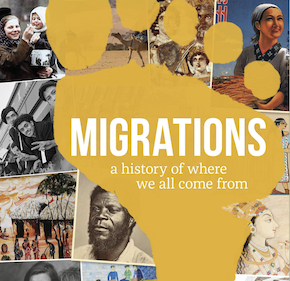Maria Irene
“Migrations: A History of Where We All Come From” by DK, with a foreword by David Olusoga, is a brilliantly written and visually captivating exploration of the history of human migration. It delves into the myriad reasons behind our ancestors’ journeys across continents, the development of diverse cultures, and the impact migration has had on the world. The book masterfully combines historical accounts, scientific findings, and personal stories to provide readers with an engaging and enlightening experience.
The book starts with a foreword by David Olusoga, a renowned historian and broadcaster, who sets the tone for the narrative. He eloquently presents the importance of understanding human migration as a fundamental aspect of our shared history. Olusoga’s introduction highlights the fact that our ancestors’ migrations have shaped the world we know today, and that understanding this process is vital for fostering a sense of global unity and empathy.
The main content of “Migrations” is divided into six sections, each focusing on a different aspect of human migration. These sections are chronologically ordered, starting with the earliest human movements and ending with present-day migration patterns.
- The First Migrations: This section delves into the earliest human migrations, starting with the Out of Africa theory. It investigates how our ancestors began their journeys, driven by a combination of environmental factors, resources, and curiosity. The section also explores the development of early human societies and how these groups adapted to new environments.
- Ancient Migrations: This part of the book focuses on the early civilizations and their migration patterns, including the Sumerians, Egyptians, and Indus Valley people. It discusses the reasons behind their movement, from economic and political factors to natural disasters, and the impact these migrations had on the development of new cultures and societies.
- Medieval Migrations: This section delves into the complex migration patterns of the medieval period, examining how different groups of people moved across the world due to religious, political, and economic reasons. This part of the book discusses the migrations of various peoples, such as the Vikings, Moors, and Mongols, and their impact on the world at that time.
- Colonial Migrations: This part of “Migrations” examines the movement of people during the colonial period, which saw the rise of European powers and their expansion into the Americas, Africa, and Asia. It discusses the forced migration of enslaved people, as well as voluntary migrations for economic and religious reasons. This section highlights the far-reaching consequences of colonialism and how it shaped the modern world.
- The Age of Mass Migration: This section delves into the mass migrations that occurred during the 19th and 20th centuries, including the movement of people from Europe to the Americas, and the internal migration within countries, such as the Great Migration in the United States. It also discusses the impact of migration on the development of nation-states and the influence of political ideologies on migration policies.
- Contemporary Migrations: The final section of “Migrations” examines the current state of migration, including the global refugee crisis, the impact of climate change on migration, and the role of technology in facilitating movement. This part of the book also discusses the political and social implications of migration in the modern world, such as the rise of nationalism and debates on immigration policy.
“Migrations” is richly illustrated with maps, photographs, and artwork, which serve to enhance the reader’s understanding of the migration patterns and the cultural landscapes that have evolved over time. The images not only provide context but also showcase the diversity and beauty of the human experience.
One of the most striking aspects of “Migrations” is its ability to humanize
the migration process. Throughout the book, personal stories of migrants are interspersed with historical accounts and scientific findings, providing readers with an emotional connection to the individuals who have shaped our world. This narrative choice helps to dispel misconceptions about migrants and highlights the resilience and adaptability of the human spirit.
In conclusion, “Migrations: A History of Where We All Come From” is an excellent resource for anyone interested in understanding the complex history of human migration. Its comprehensive approach, engaging narrative, and stunning visuals make it a must-read for history enthusiasts, educators, and general readers alike. It is a reminder that migration is a fundamental part of our shared human experience, and that understanding our past is crucial for navigating the challenges of the present and future.
For those who wish to delve deeper into the topic of migration, particularly economic migration, here is a suggested reading list:
- “The Warmth of Other Suns: The Epic Story of America’s Great Migration” by Isabel Wilkerson – This book tells the story of the Great Migration of African Americans from the rural South to the urban North in the 20th century, driven by economic opportunities and the desire for a better life.
- “The World is Flat: A Brief History of the Twenty-first Century” by Thomas L. Friedman – This influential book examines globalization and the impact of technology on the world economy, including the movement of people for economic reasons.
- “Arrival City: How the Largest Migration in History is Reshaping Our World” by Doug Saunders – This book explores the role of cities as hubs for economic migration and the challenges and opportunities they present for both migrants and their host communities.
- “The International Handbook on the Economics of Migration” edited by Amelie F. Constant and Klaus F. Zimmermann – A comprehensive collection of essays examining the economic aspects of migration from various perspectives, including labor markets, human capital, and policy implications.
- “Global Migration: Patterns, Processes, and Politics” by Elizabeth Mavroudi and Caroline Nagel – This book provides a comprehensive overview of global migration trends and the political, economic, and social factors that drive them.
By exploring these works, readers can gain a more thorough understanding of the complex factors that drive economic migration and the impact it has on both sending and receiving countries.


